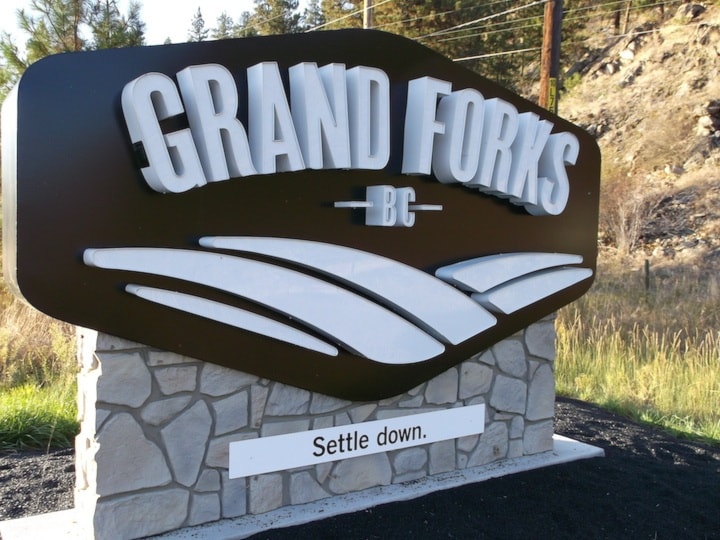Seventy-fifth in an alphabetical series on West Kootenay/Boundary place names
Although Grand Forks’ name isn’t mysterious or unusual, its origin is convoluted enough that we’ll devote two installments to it.
Many sources state Grand Forks was originally called Grand Prairie or Grande Prairie, which is true, but Grande Prairie actually referred to the entire valley; Grand Forks was a townsite within Grande Prairie. For a while, both names were used simultaneously.
In a 1930 interview published in the Boundary Historical Society’s 10th report, Sydney Russell Almond (namesake of the Almond Gardens neighbourhood) stated: “The name [Grand Forks] was used by the few people living just in the vicinity, but we old settlers always used Grande Prairie for the entire district, the forks included. Grande Prairie was what the district was known as long before there was any Grand Forks and that name was never heard generally until after the town started.”
Grande Prairie was named in early October 1859 when the British Boundary Commission and its American counterpart surveyed the 49th parallel between BC and Washington. A party of Royal Engineers camped near present-day Grand Forks, and their officer in charge, Lt. Henry C. Palmer, sketched the area showing a possible military road through the valley. He wrote: “At the confluence of the three valleys occurs a large plain, three miles by two, designated in the plan La Grande Prairie.”
It was so labelled on a map they produced in March 1862.
In the Manitoba Free Press of March 21, 1890, John Douglas of the Douglas Mining company of Rock Creek explained: “Cascade City is on the eastern limit of Grand Prairie.”
The earliest mention of Grand Forks is in a diary entry by Robert (Seattle) Clark dated April 5, 1894, and quoted in the Boundary Historical Society’s 15th report. An earlier, undated entry from that year said “Starting a townsite at North Fork bridge. Wiseman starting to put up a hotel.” Clark’s daughter Ella is sometimes credited with choosing the name Grand Forks. Others say it was the Manly family.
The first newspaper mention is in the debut issue of the Fairview Advance, dated April 26, 1894: “The new townsite at the junction of the North Fork of the Kettle River with the main stream is to be called Grand Forks.” The same issue added: “The Grand Prairie valley, in which there are over 90 settlers, has no store of any kind, though one is now being built at the new townsite.”
Angus K. Stuart of the Advance wrote to Member of Parliament J.A. Mara on September 3 that a post office was needed at “Grand Forks in Grand Prairie.”
But the new name took a while to catch on, for the Advance of December 5 (which by that time had moved to Midway) still carried ads for the “Grand Prairie Hotel, Grand Prairie, Kettle River, BC.” and the “Grand Forks Hotel, Kettle River, BC.”
The Grand Forks post office opened January 1, 1895 and the city was incorporated April 15, 1897. Gradually, the name Grande Prairie died out — no doubt partly due to confusion over another Grande Prairie southeast of Kamloops, and yet another in what is now Alberta. (It didn’t seem to matter that there was a much larger Grand Forks in North Dakota.)
But the naming of Grand Forks was not yet settled.
Next: Piedmont, Miner, or Ystradyfodwg?
Previous installments in this series
Applegrove, Appleby, and Appledale revisited
Bakers, Birds, and Bosun Landing
Bannock City, Basin City, and Bear Lake City
Bealby Point (aka Florence Park) revisited
Boswell, Bosworth, Boulder Mill, and Broadwater
Brooklyn, Brouse, and Burnt Flat
Camborne, Cariboo City, and Carrolls Landing
Carmi, Cedar Point, Circle City, and Clark’s Camp
Carson, Carstens, and Cascade City
Christina City and Christian Valley
Cody and Champion Creek revisited
Champion Creek revisited, again
Columbia City, Columbia Gardens, and Columbia Park
Crawford Bay and Comaplix revisited
Dawson, Deadwood, and Deanshaven
English Cove and English Point
Forslund, Fosthall, and Fairview
Fort Shepherd vs. Fort Sheppard, Part 1
Fort Shepherd vs. Fort Sheppard, Part 2
